St. Louis history going up in smoke
Reflecting on the loss of the Beck & Corbitt Iron Co. warehouse in North STL
I hadn’t anticipated writing another post this week, but I wanted to mark the demise of a small piece of St. Louis history, as its passing helps tell a larger story of decay and loss throughout the city.

A century-old warehouse in North St. Louis burned to the ground on Tuesday. One of many such fires over the years, it was remarkable mainly because of its intensity: it was a five-alarm fire, the first in several years in the city, and required more than 100 firefighters to respond.
For most people, it was just another abandoned building left to rot, and its destruction allows the city to clear away more of its tainted landscape. But for some of us—including several people I met on Thursday when I went to inspect the aftermath—the fire represents the loss of another piece of St. Louis history.
The fire
The fire broke out at the former Beck & Corbitt Iron Company warehouse located at the intersection of N. 1st and O’Fallon St., at approximately 7 pm on Oct. 25th. It took firefighters a couple of hours to put out the fire. According to the St. Louis Post-Dispatch, firefighters worried that with the high winds, embers might ignite nearby buildings, including the former Laclede Power Plant just to the east (and in fact, I found bits of charred wood all the way to the Ashley Power Plant gate just down the street). Collapsing brick walls added to the peril.
Fortunately, only one person was injured. Firefighters found him outside the structure with a laceration, and he was transported to the hospital with non-life-threatening injuries. Firefighters believe he may have been living inside the building. According to one TV report, St. Louis Fire Chief Dennis Jenkerson believes both this fire, and one the following night at another warehouse, ”were most likely caused by homeless people trying to stay warm during colder nights.” With a significant unhoused population and a plethora of empty structures, this is a tragic story that plays out over and over again across the downtown area.
Beck & Corbitt Iron Company
In the 19th and early 20th centuries, St. Louis was a major manufacturing city. Along the riverfront and throughout downtown there used to be dozens—hundreds—of sturdy brick factories, warehouses, shipping depots, and other structures employed in the manufacture of everything from candy to beer to candles to shoes. Being a major port city, St. Louis was (and still is) a major hub of trade and the transfer of goods by rail, truck, and river barge.
It was therefore natural that a business such as the Beck & Corbitt Iron Company would make its home here. Founded in 1852 as a distributor of iron and steel products, it sold a wide range of mining, factory, and metalworking supplies. Much later the company would shift to processing and manufacturing steel products, and would continue in business—with operations in nine states—until it was acquired by Lapham-Hickey Steel Corp. in 1981.
According to a 1912 catalog, some of the hundreds of items the company sold included steel and iron pipe, steel sheets, steel roofing, and rivets, bolts, and screws. They also sold welding equipment and supplies, drafting supplies, pulleys, chains, gears, drills and drill bits, and valves.
The warehouse itself
The Beck & Corbitt Iron Company warehouse on N. 1st Street was built in 1911. At that time, the area was a beehive of industrial activity. Its neighbors include the Laclede Power Company constructed in 1901 (video of interior), the Ashley St. Power House (formerly Union Electric) built in 1902, and the Cotton Belt Freight Depot, a former freight depot for the St. Louis Southwestern Railway and listed on the U.S. National Register of Historic Places since 2004.

While I couldn’t find any contemporary photos of the warehouse, here are a few photos from Google Street View from 2012 and 2019.

After initially posting this article, I discovered that a local photographer, Josh Medsker, had taken some interior shots about a week before the fire, and posted them on his Facebook page. Nothing can really convey the loss of a building as much as seeing it just before it’s gone. I’m sharing four of the images, but there are more on his page.
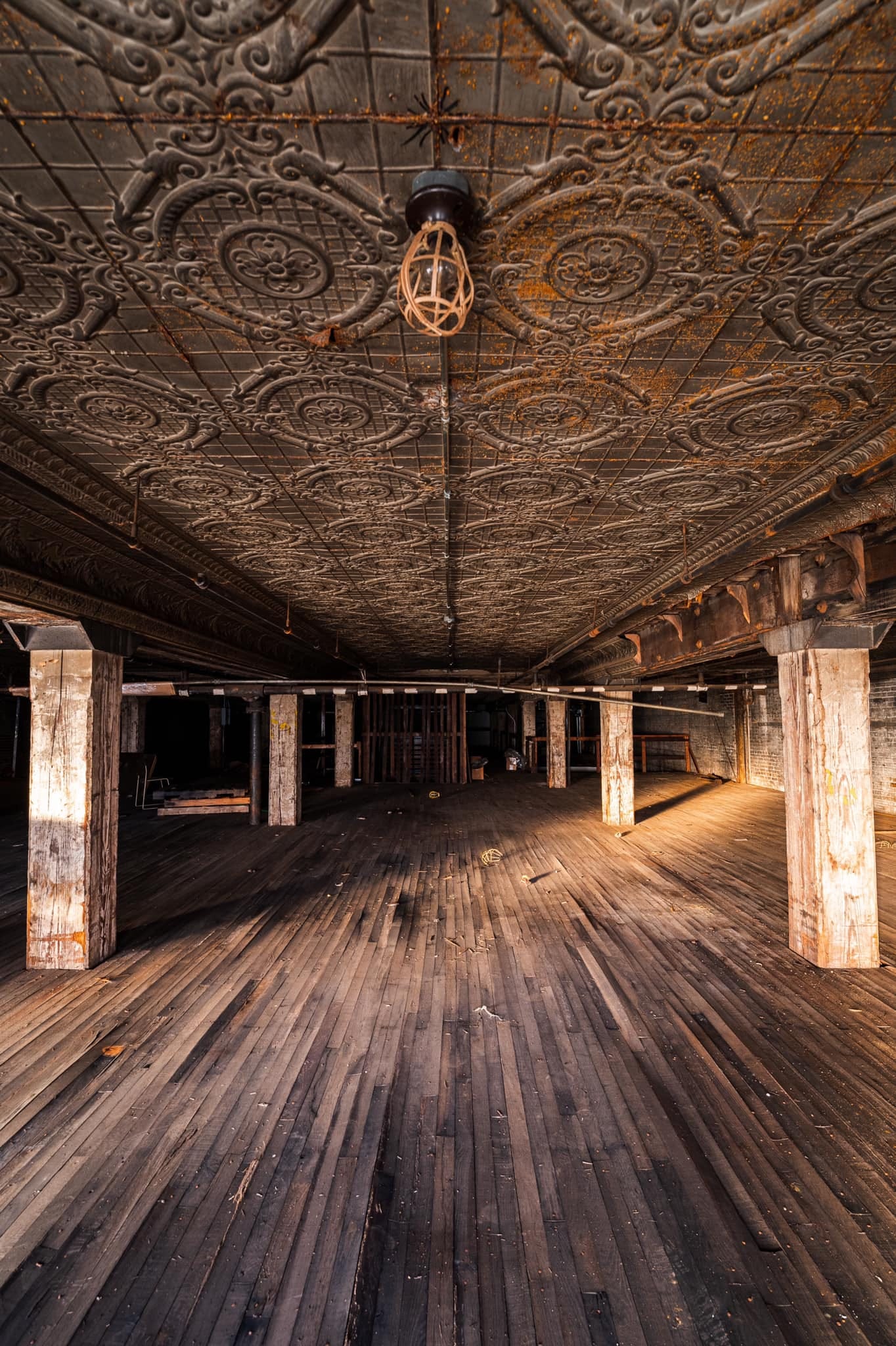
An area in decline
Although things were hopping in St. Louis when the warehouse was built, manufacturing and commerce began to decline several decades later (along with the city’s population). However, some companies, such as Beck & Corbitt, actually expanded during this time, and in 1956 the company moved out of this North St. Louis warehouse to a large modern facility on S. Spring Avenue adjacent to the rail yards in Mill Creek Valley.
The problem was, rather than renovate their existing structures, which were considered old-fashioned and undesirable (keep in mind, none were air-conditioned), many other businesses followed in Beck & Corbitt’s footsteps, abandoning their downtown digs and relocating to modern facilities elsewhere. Others simply closed up shop without anyone new moving into the space. With declining demand for warehouse and factory space, some of the buildings remained empty for years, if not permanently.
As a result, many brick buildings from the city’s manufacturing heyday were left fallow throughout downtown St. Louis and adjacent areas. With neither tenants nor ongoing maintenance, all buildings will decay over time, and in St. Louis, quite a few fall victim to fires.
To give you an idea of the area around the 1911 Beck & Corbitt Iron Co. warehouse, I’ve included a screenshot from Google Maps. The warehouse was close to Interstate 44 and just a few blocks north of the Four Seasons hotel and Laclede’s Landing. Some locals may know the area for the Laclede Power Station that stands between it and the river, and tiny Rootwad Park, an odd gem of a park designed by Bob Cassilly of City Museum fame.
But unlike a century ago, when the land would have been packed with warehouses and factories, today there isn’t a lot else in the area. As you can see, the area is mostly parking lots, empty space, and an operating power station and an electrical substation.
Rubble and smoke
The fire was extinguished in roughly two hours, but it wasn’t done. The embers within the former warehouse smoldered on overnight, and the fire kicked up again on Wednesday, needing additional fire department support. From what I can tell from news reports, that may have been when the remaining walls collapsed.

When I visited the site on Thursday, thinking to investigate the remains of the building before crews cleared the site, I was surprised to see a St. Louis Fire Department engine extinguishing a small fire that had come back to life in the center of the rubble. Nearly 48 hours later and the fire wasn’t done yet.
It was also both fascinating and tragic to see the large building reduced to a massive pile of individual charred red bricks scattering the lot. As I learned from reading about previous fires, the combination of the heat of the fire and then the high pressure from firefighter hoses softens the mortar and causes heavy brick walls to crumble like a sugar donut.
When the once-mighty walls collapsed, bricks tumbled a good distance from the original building footprint. What remains is a metal tank in what would have been the center of the building (a boiler?), and twisted metal beams and pipes stick out from the rubble like broken skeletons.
Aftermath
Below are several photos I took of the rubble two days after the fire.
Finally, I’ll leave you with one more photo. The irony needs no further comment.
Thanks for reading this impromptu edition of Unseen St. Louis. If you enjoyed this piece, be sure to check out my other articles. And I’d love it if you’d share it with a friend.
P.S. If you came here because of the link in the comments on George Saunders’ Story Club post, welcome! I hadn’t seen his post before writing this piece, and just now discovered someone had linked to my Substack from his comments. And for what it’s worth, I was at his talk on Wednesday night, which was super inspiring. At any rate, it’s both weird and exciting that we both took a moment to reflect on the fire.





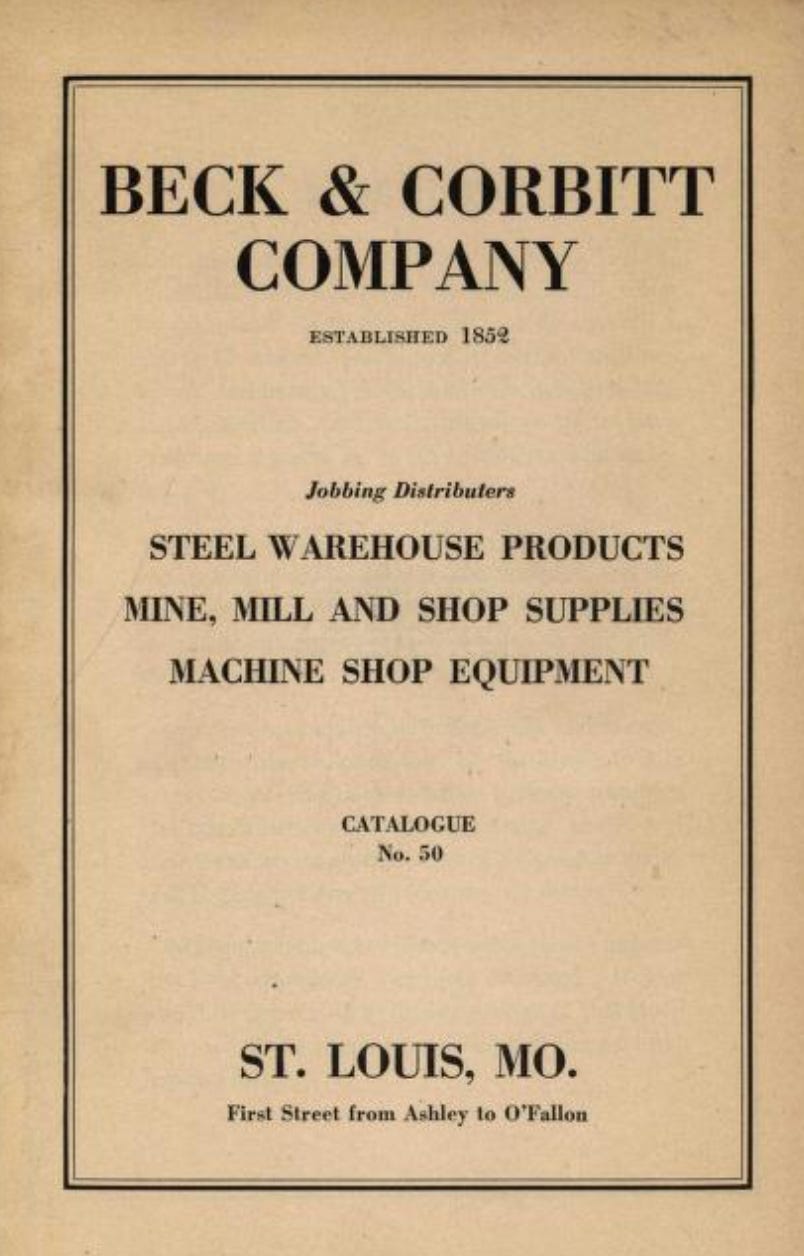

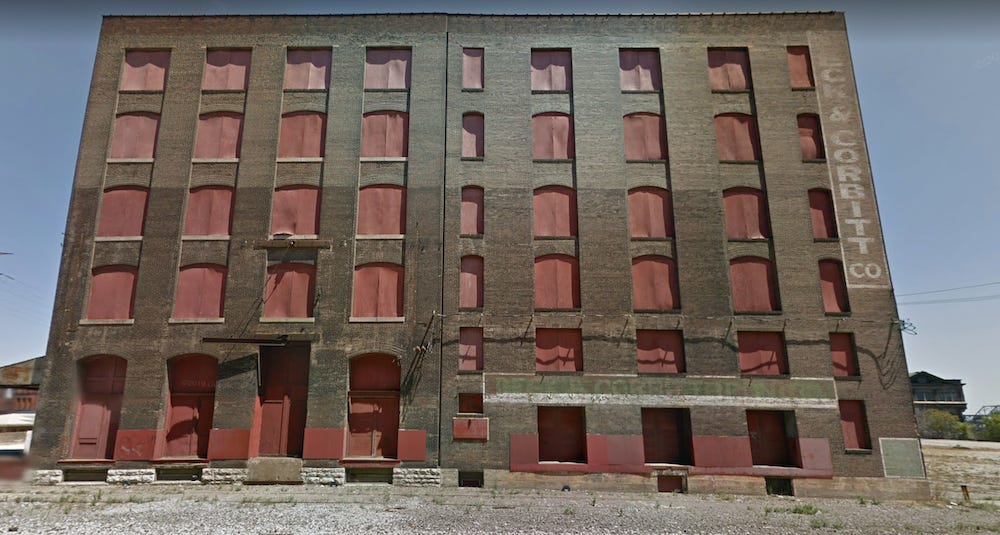


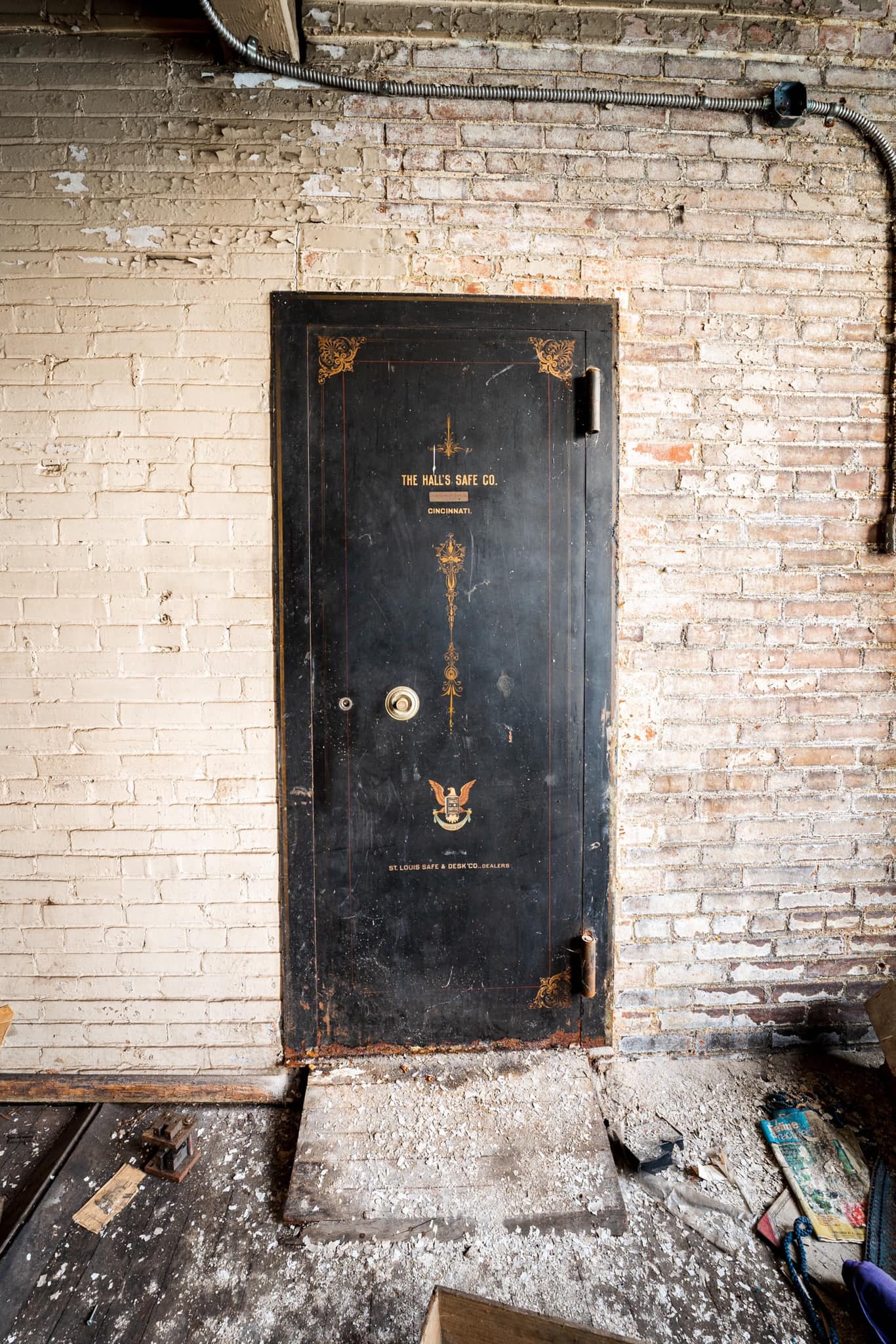



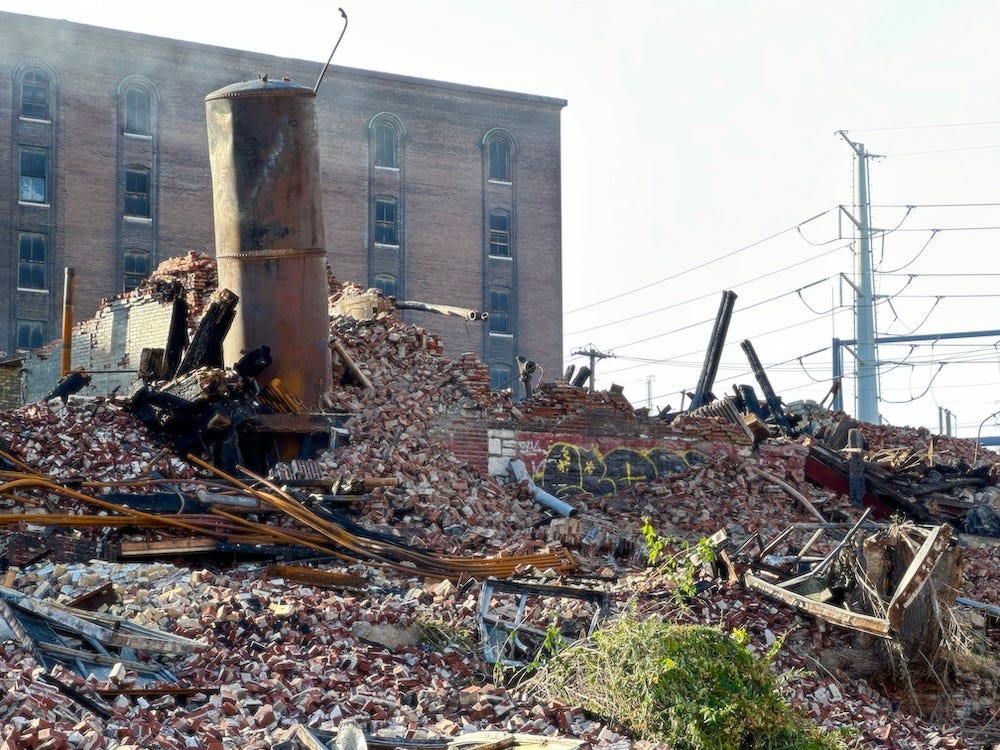
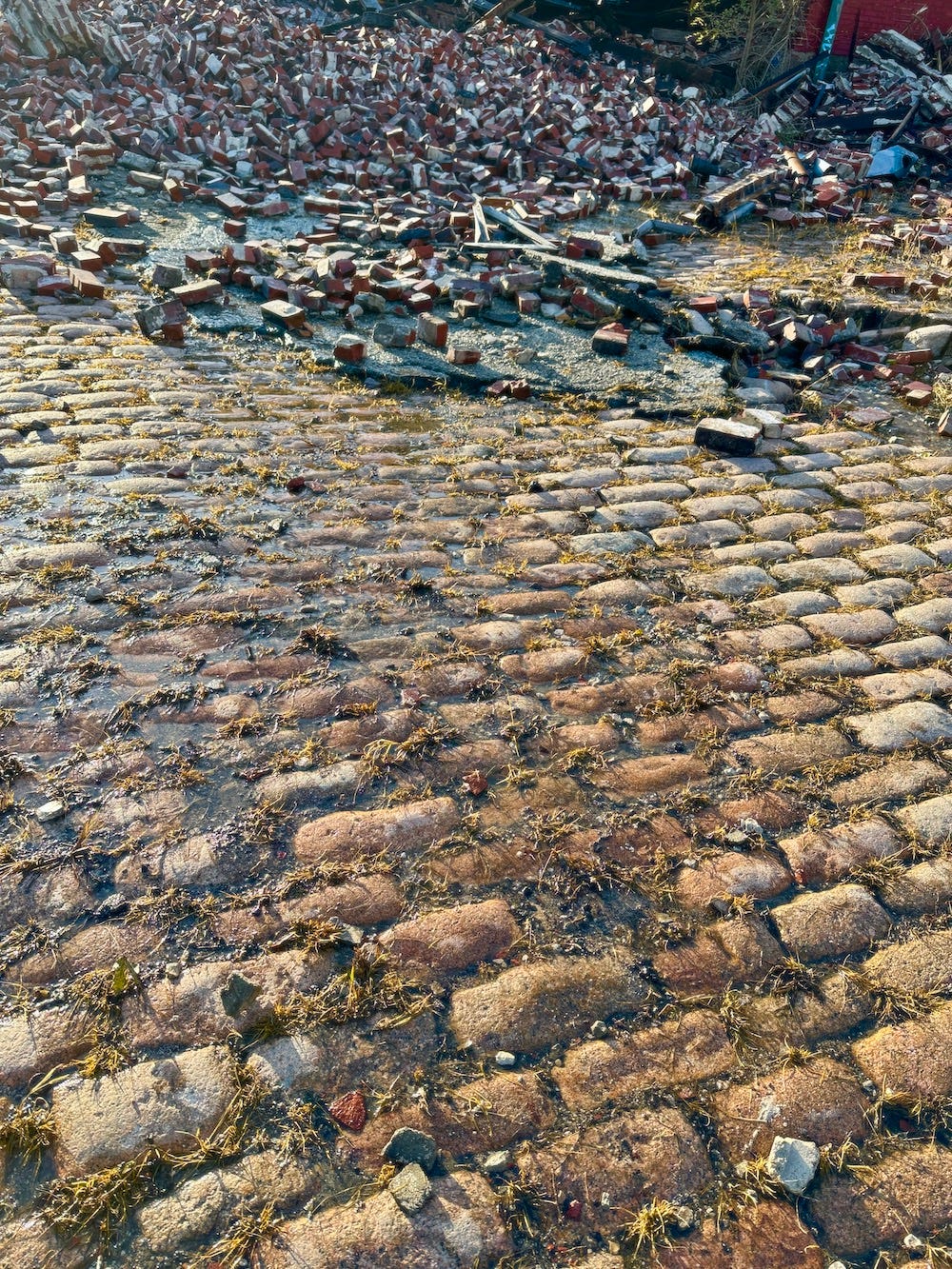





Such good research related to one specific area in your city. I love it.
So many cities have these structures with so much potential but they are left to ruin because of lack of funds and imagination. It hurts the cities, it hurts the environment, and it hurts the people with the eyesores in their backyards. The question I always have is, how do we fix that?
Thank you for sharing St. Louis history with us via your writing!